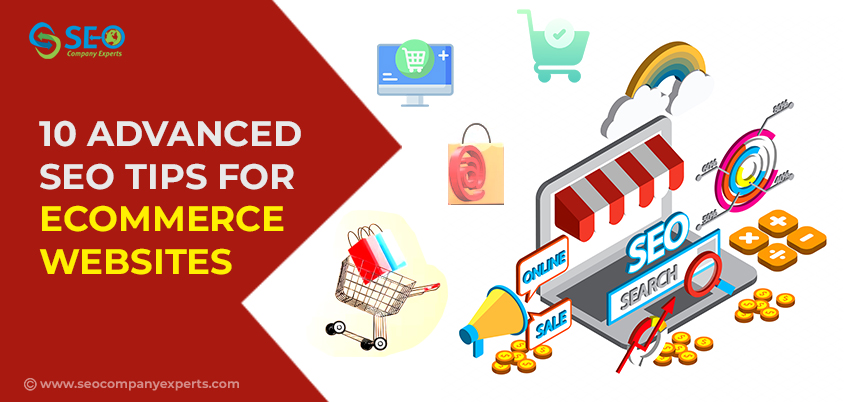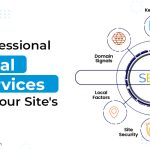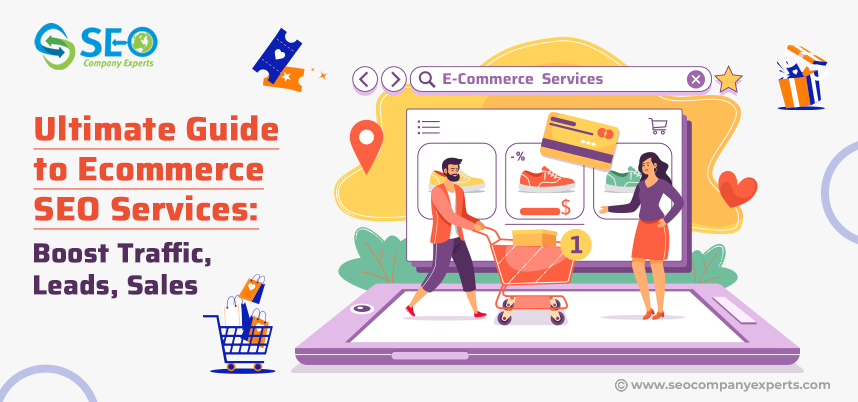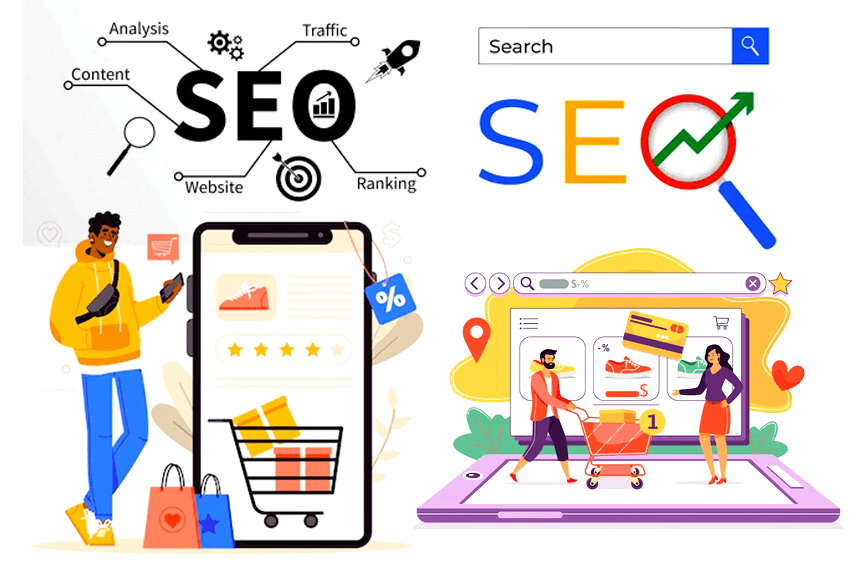

10 Advanced SEO Tips for eCommerce Websites
The race to reach the top of Google Results is never-ending. With the escalating number of eCommerce websites these days, it’s essential to take active steps to drive relevant footfall to your website. For this purpose, one must engage a prominent team to receive ecommerce SEO services USA. Their customized strategies help you grow your online store manifolds and yield huge revenue.
This blog shares ten advanced SEO tips for eCommerce business owners that help enhance visibility, traffic, and sales. So, read our blog for knowledgeable insights. And, to generate effective outcomes, we suggest you approach professionals to let your online store stand out in a competitive market.
Advanced SEO tips for eCommerce website
Conduct a website SEO audit:
To commence your advanced SEO tips, conduct a thorough SEO audit to understand your website’s current status better. Here’s what you can look for while auditing:
Determine Optimization opportunities: Proper website scrutiny helps pinpoint areas of improvement in the website and its technical structure. Focus on on-page elements like URLs, meta titles and descriptions, H1 and H2 tags, and images, and look for optimization opportunities. These improvements positively impact search engine rankings and help you drive website traffic.
Work on enhancing user experience: Check page speed, mobile-friendliness, and navigation. Troubleshoot any issues you may find to improve the overall user experience, leading to higher engagement and conversions.
Check keyword relevancy and indexing: Check the keywords you are currently ranking for and those that are performing poorly. Also, ensure proper indexing to increase the likelihood of the website’s appearance in search results.
Perform competitive analysis: It would be best to analyze the competitor’s SEO strategies. Besides, compare the website’s performance metrics, such as backlink profiles, keyword rankings, and more, against competitors. This helps modify the current strategies and set realistic goals and benchmarks for improvement.
Optimize Product Descriptions:
It’s proven that incorporating relevant keywords in your product can do wonders. It drives your product page ranking and enhances traffic to your eCommerce site. Here’s how to optimize the product descriptions:
Write unique content: Add unique descriptions that are not copied from other sources. Avoid duplicacy in content, as it will negatively impact your SEO efforts and lead to penalties. To generate better outcomes, it would be best to contact a prominent eCommerce SEO company.
Keyword optimization: Add appropriate keywords to product descriptions that users will likely search for. This improves product visibility by ensuring that the products are shown to customers looking for them.
Use descriptive language: Always prefer descriptive language to precisely portray the product’s features, benefits, and uses. This helps with SEO and assists potential customers in making informed purchasing decisions.
Incorporate rich media: Include top-quality videos, images, and infographics in your product description. It amplifies the user experience and significantly boosts engagement. Optimizing these media files with relevant alt text and filenames can also improve SEO.
Work on On-page SEO:
On-page SEO involves different website elements that one can optimize to improve search engine rankings. Here is what’s all involved:
Optimizing Meta tags: This element provides information about a webpage to search engines and users. It involves two components: meta title and meta description. The meta title is a clickable headline displayed on SERP. Keep it concise and keyword-rich. The meta description is a short snippet of the content of the web page. It must be informative and persuasive, with suitable terms that entice users to click through to the webpage.
Semantic SEO: Semantic SEO involves creating comprehensive and high-quality content by understanding what users are looking for. Instead of stuffing content with repetitive keywords, add broader context and meaning behind those keywords.
Multilingual SEO: One should optimize content for multiple languages and geographic regions. It includes adding hreflang tags, localized content, and international keyword research. This practice enables reaching a wider audience and improving visibility in local search results.
Technical SEO: It comprises different elements that you can optimize to make your website more indexable, crawlable, and technically sound. One can adjust web content in a logical structure and offer clear navigation to let search engines and users understand the site’s architecture. Besides, creating SEO-friendly URLs, implementing HTTPS encryption, canonicalization, and 404 errors and redirects all need to be taken care of. Addressing these technical aspects by hiring a renowned eCommerce SEO agency helps owners refine their site’s performance, user experience, and search engine visibility.
Implement Schema Markup:
Implement schema markup to assist search engines in understanding the page’s information. Here’s what you have to do:
Determining relevant schema types: Firstly, specify which schema types are suitable for your website’s content. This could involve schemas for products, events, articles, recipes, reviews, and so on. Choose the suitable one based on the content you offer.
Markup implementation: Once the appropriate schema type is identified, you need to implement it within your HTML code. This involves adding specific markup syntax to your content using Mircodat, JSON-LD, or RDFa formats.
Structuring data: Each schema type has its own set of features. You can utilize it to furnish more detailed information. For example, if you are marking up a product, you can include properties like name, price, image, description, availability, etc.
Testing markup: One must test the implemented schema markup using tools such as Structured Data Testing tools by Google. These tools help you validate your markup and pinpoint errors or warnings that need to be handled.
Optimize Product Images:
Optimizing product images boosts their visibility on search engines, fostering more organic traffic to your website. Here’s how the best eCommerce SEO services provider do so:
File names and Image size: Always use descriptive file names with relevant keywords. Also, compress images to reduce file size without compromising quality. You can use formats like JPEG or WebP for better loading speed. Hiring eCommerce SEO services USA is the finest way to deal with the technical aspects of SEO.
Alt tags and Image sitemaps: Include alt text with relevant keywords to enhance accessibility and allow search engines to understand the image content. Besides, create a proper image sitemap to help search engines discover and index images more efficiently.
Image optimization plugins: You can use plugins or tools to automate image optimization processes and ensure consistency across the website.
Work on Mobile Optimization:
Your business website must be optimized for mobile devices. It improves SEO and caters to individuals using mobile devices.
Choose adaptable web designs: Make sure the design you prefer adjusts flawlessly across different screen sizes. Also, maintain uniformity on every device, whether smartphones, desktops, or tablets, to deliver a consistent experience.
Mobile-first indexing: It is suggested to hire an eCommerce SEO agency for assistance related to mobile-first indexing. These experts ensure your mobile version holds the same content and structured data markups as your desktop version. Google primarily uses the content’s mobile version for indexing and rankings.
Mobile-friendly navigation: Ensure quick navigation and simplify menus and buttons for touchscreens. They should be visible without the need for pinch-to-zoom.
Pop-ups and interstitials: Dodge unnecessary interstitials and pop-ups as they can disrupt the experience of users. Always seek approval from users to send notifications and updates.
Mobile usability testings: Get an SEO service package that includes regular mobile usability testing. It helps determine and troubleshoot issues that may arise with the rollout of new updates or as registered by users.
Develop strategic product categories for SEO:
One must focus on creating strategic product categories for their eCommerce website. Here’s what owners can do:
Keyword research and mapping: Determine relevant search terms and map them to specific product categories, considering search intent and relevance.
Unique category name and description: Choose keyword-optimized category names and write unique and persuasive product descriptions to enhance SEO and provide valuable information to users.
Internal linking: Implement strategic internal linking between category pages. Besides, use relevant anchor text to signal the relationship between linked pages and improve indexing.
Build relevant backlinks:
Creating high-quality backlinks is vital to improving SEO rankings. This enhances your website’s credibility and authority among users and Google. Here’s what is involved in link building:
Content Promotion: Actively promote your content through multiple channels, including social media, industry forums, and high DA sites.
Guest Blogging: Discover authoritative websites in your industry that accept guest posts. Craft informative posts that offer value to their client base while including relevant links back to your eCommerce website.
Broken link building: Determine websites linking to relevant content that does not exist anymore. Then, reach out to the website owners and offer to replace the broken link with links to your content.
Page speed optimization:
Page speed optimization is crucial as it directly impacts user experience. Here are advanced tips for page speed optimization that many SEO firms and eCommerce website design companies use.
Compress and optimize images: Compress images and use appropriate file formats like JPEG, PNG, or WebP. Also, specify image dimensions in HTML to prevent browser reflow and improve rendering speed.
Minify HTML, JavaScript, and CSS: Remove immaterial characters from HTML, CSS, and JavaScript files to lower file sizes. Merge multiple CSS and JavaScript files into one file to lessen HTTP requests. Besides, use tools and plugins to automate file minification.
Enable Browser caching: Set suitable cache-control headers to instruct the browser to cache static resources like CSS, images, etc. In addition, establish cache expiration times to reduce server load.
Partner with relevant brands and influencers:
Collaborating with relevant brands and influencers is a powerful strategy. It helps escalate brand visibility and obtain quality backlinks. Let’s discuss this in brief:
Discover relevant influencers: Search for brands and influencers that align with your brand and target audience and have a robust online presence.
Build relationships: You can approach potential influencers through email, social media, and networking events. Introduce your brand and explain the value of collaboration. Work on nurturing relationships over time through regular communication.
Unite for content development: Team up with influencers to craft world-class content, including blog posts, videos, and podcasts. You can add backlinks to each other’s websites to boost referral traffic.
Conclusion
SEO is an ongoing process that requires time to yield top-notch results. However, it is vital to execute the right mix of tactics to obtain the maximum bang from your investment. This article entails ten advanced SEO tips that can help you succeed in an online business landscape.
If you are not sure about the approach or need professional help, contact SEO Company Experts. The seasoned team at this marketing firm crafts out-of-the-box strategies, keeping the latest eCommerce SEO trend in mind. Their assistance helps you skyrocket your eCommerce store sales. Reach us for a free quote today!
Let’s build your SEO-optimized website together!




![E-commerce SEO: A Simple Guide for Beginners [2024]](https://www.seocompanyexperts.com/wp-content/uploads/2024/04/Ecommerce-SEO-A-Simple-Guide-for-Beginners.jpg)

